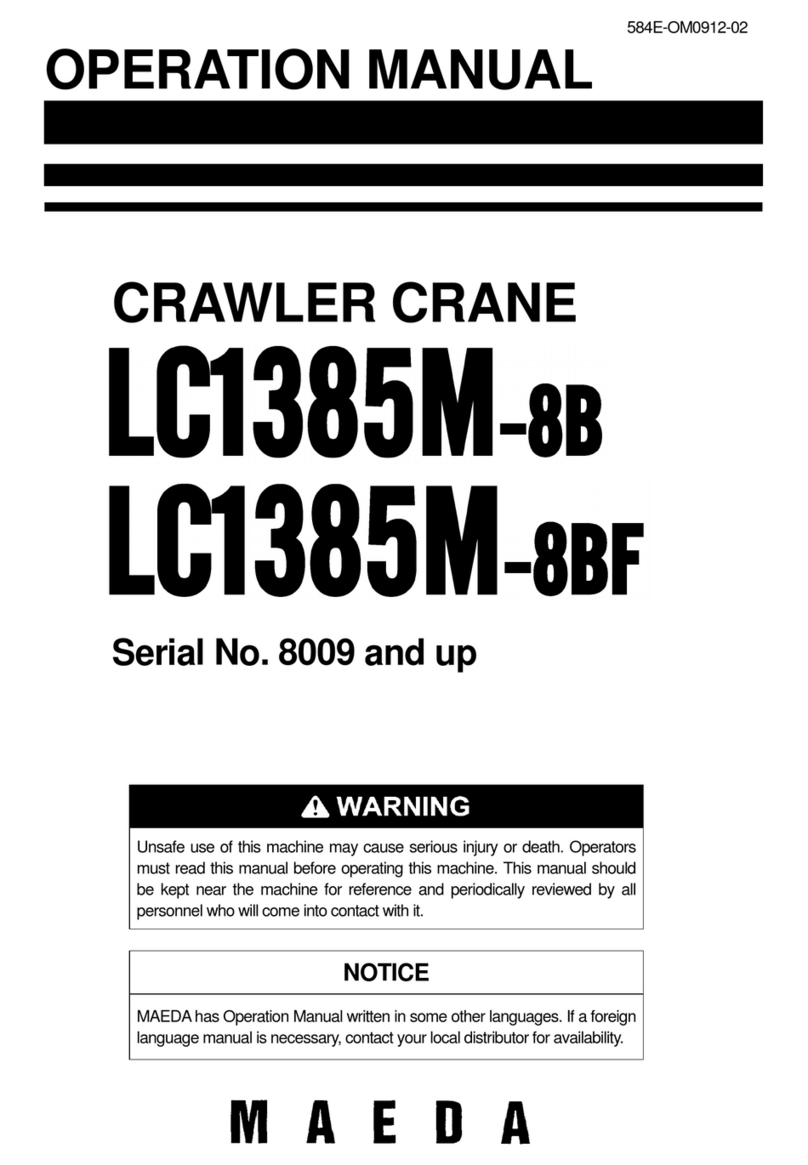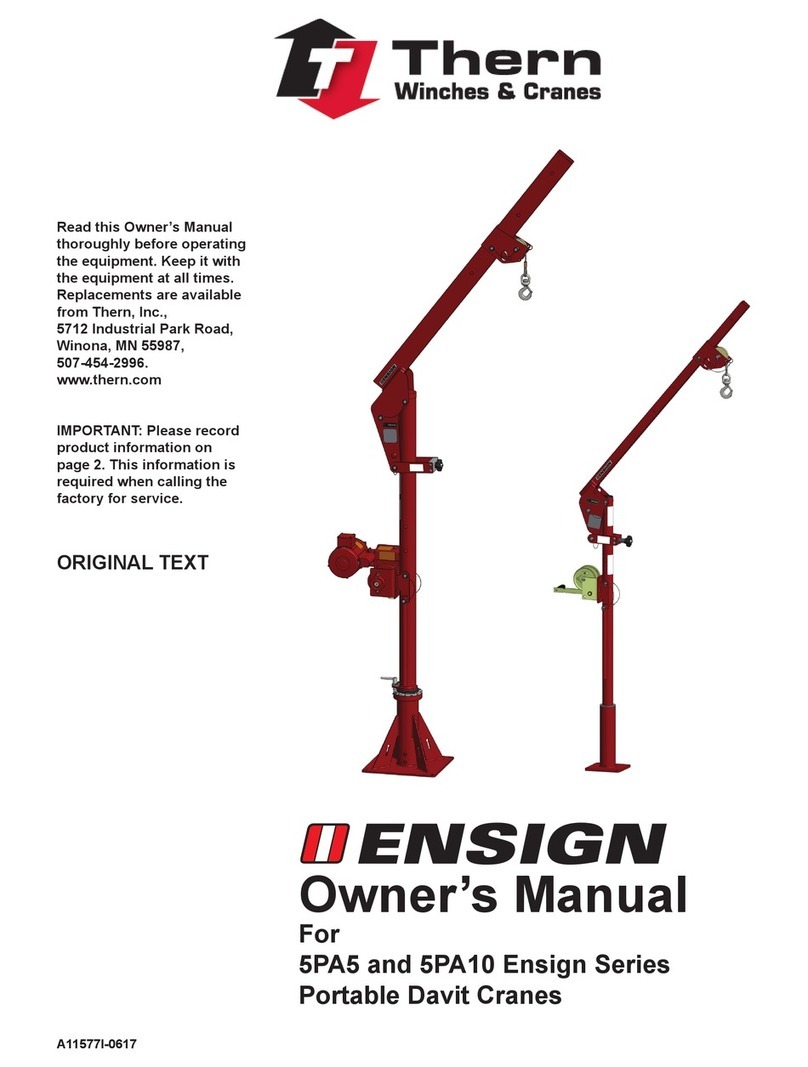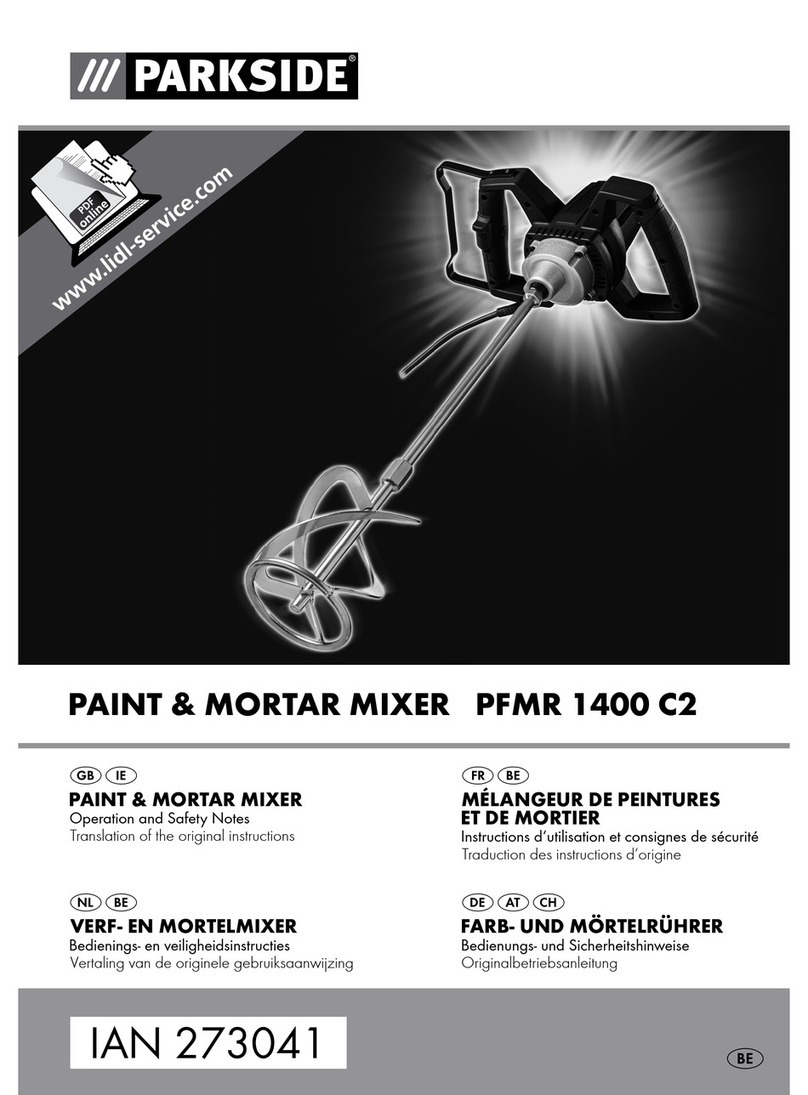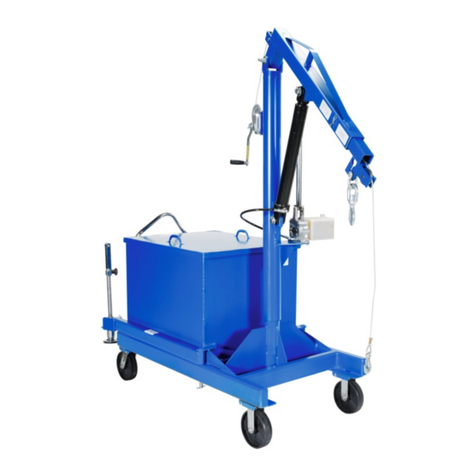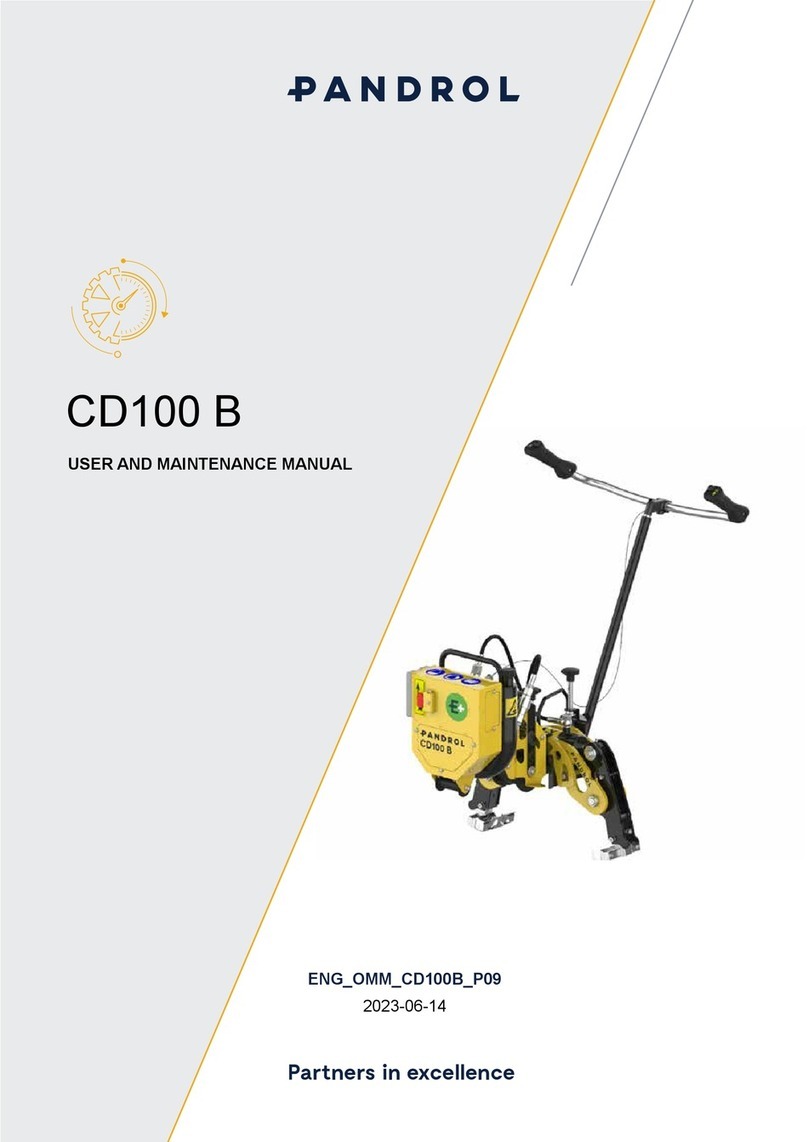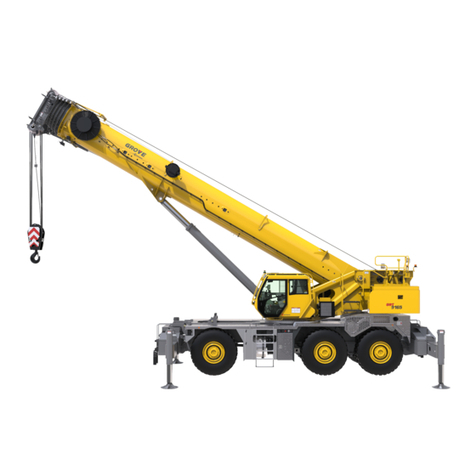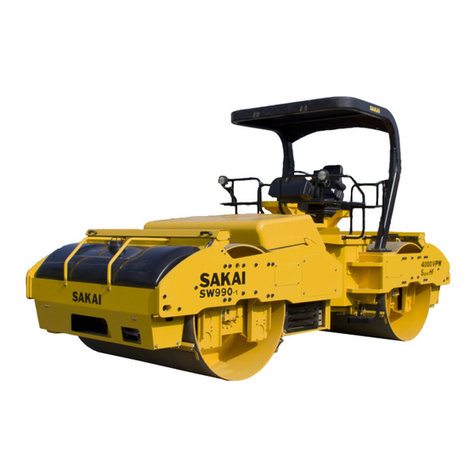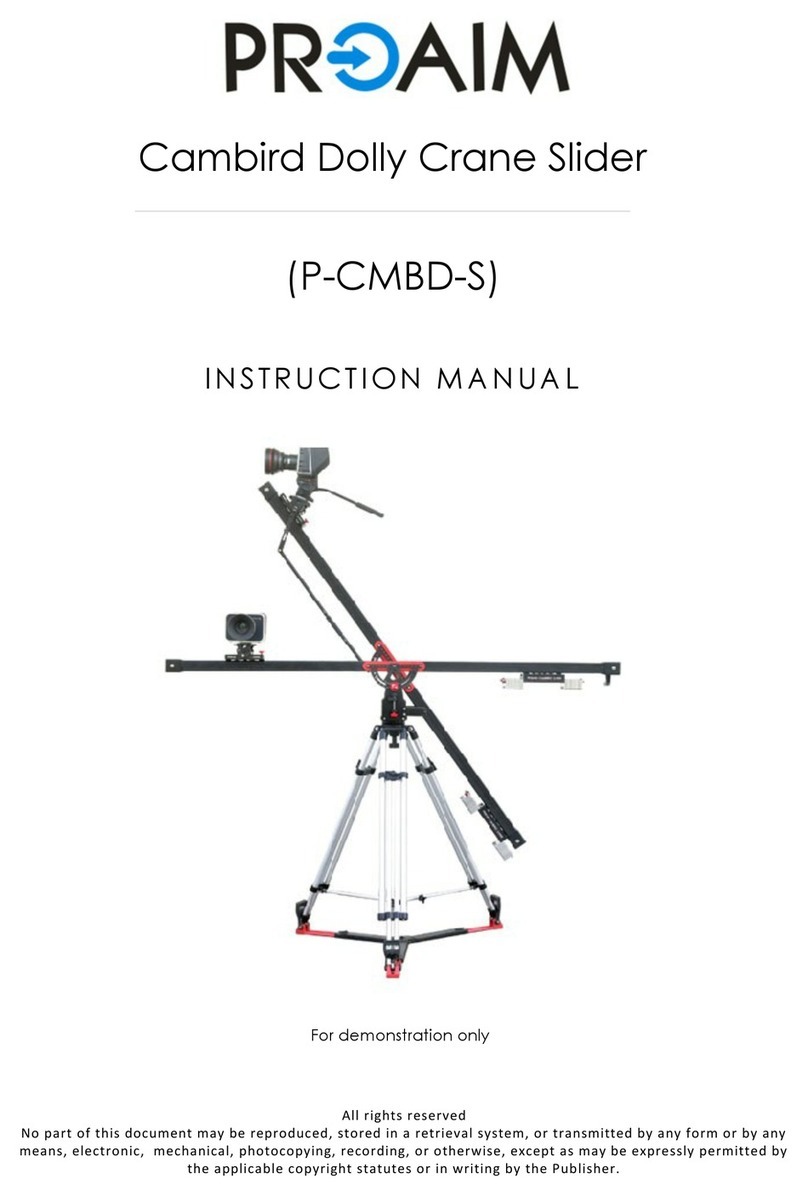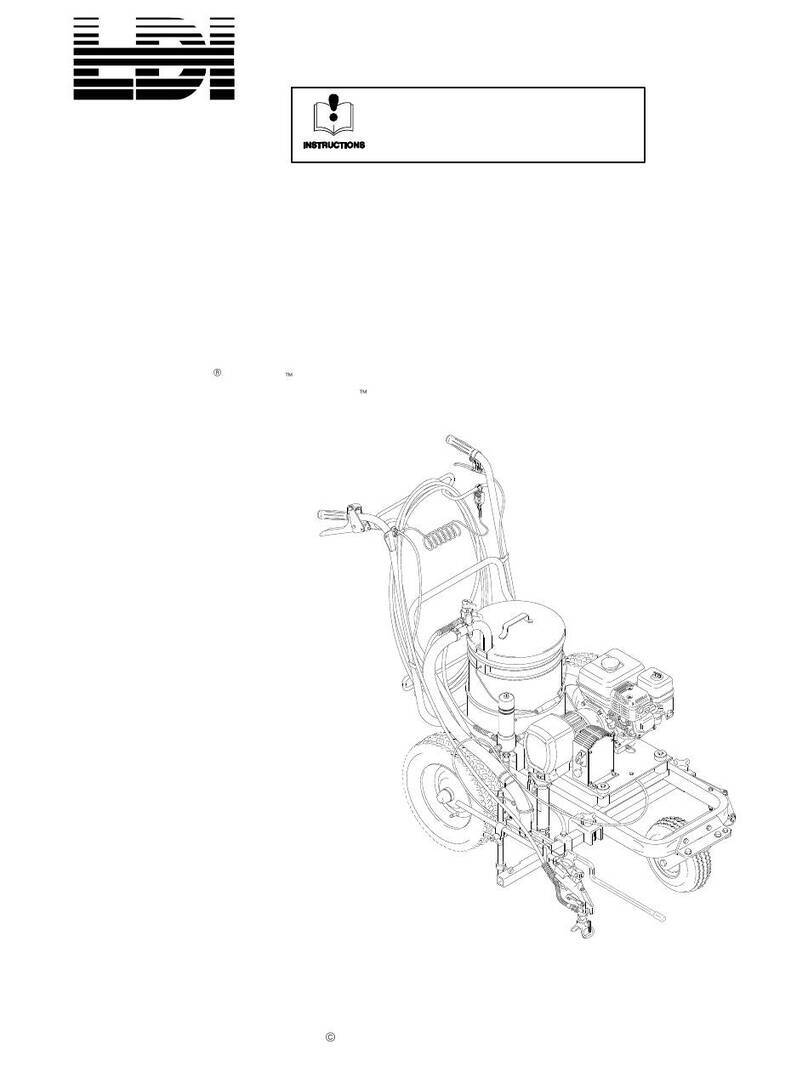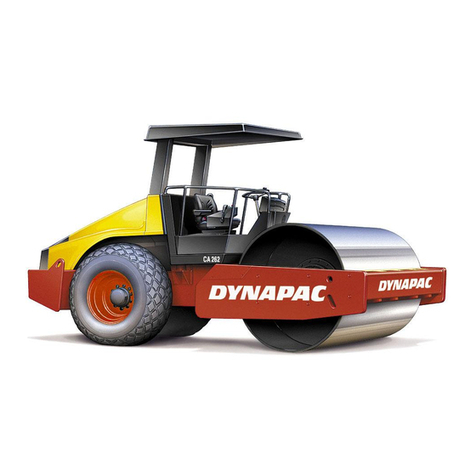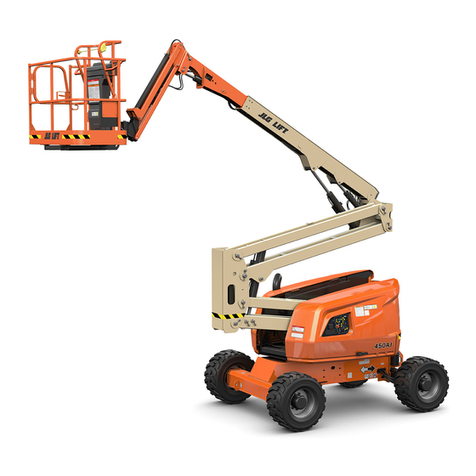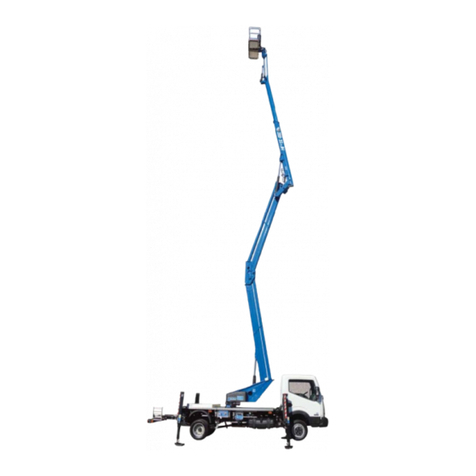Maeda CC423S-1 User manual

542E-OM1803-00
OPERATION MANUAL
CRAWLER CRANE
Serial No. 21001 and up
Unsafe use of this machine may cause serious injury or death. Operators
must read this manual before operating this machine. This manual should be
kept near the machine for reference and periodically reviewed by all
personnel who will come into contact with it.
NOTICE
MAEDA has Operation Manual written in some other languages. If a foreign
language manual is necessary, contact your local distributor for availability.
CC423S
- 1


i
CONTENTS
Item Page
INTRODUCTION 1
1. INTRODUCTION 2
2. FOR SAFE USE OF THE MACHINE 3
3. MACHINE OVERVIEW 4
3.1 SPECIFIED OPERATIONS 4
3.2 MACHINE STRUCTURE 4
3.3 MACHINE FUNCTIONS 5
4. QUALIFICATIONS FOR OPERATION 6
4.1 QUALIFICATIONS FOR CRANE OPERATION 6
5. TERMINOLOGY 7
5.1 TERMS AND DEFINITIONS 7
5.2 DIAGRAM OF WORKING RADIUS AND LIFTING HEIGHT 8
5.3 RATED TOTAL LOAD CHART 9
6. NECESSARY INFORMATION FOR SERVICING 12
SAFETY 15
1. BASIC PRECAUTIONS 16
1.1 PRECAUTIONS BEFORE STARTING WORK 16
1.2 PREPARING FOR SAFE OPERATION 17
1.3 PRECAUTIONS FOR FIRE PREVENTION 19
1.4 CAUTIONS IN GETTING ON AND OFF THE MACHINE 20
1.5 OTHER PRECAUTIONS 21
2. OPERATION RELATED PRECAUTIONS 22
2.1 PRECAUTIONS ON WORK SITE 22
2.2 CAUTIONS WHEN STARTING ENGINE 25
2.3 PRECAUTIONS FOR STARTING CARRIER AND OPERATING CRANE 27
2.4 CAUTIONS DURING CRANE OPERATION 30
3. TRANSPORT PRECAUTIONS 38
4. TOWING PRECAUTIONS 39
5. MAINTENANCE PRECAUTIONS 40
5.1 PRECAUTIONS BEFORE MAINTENANCE 40
5.2 PRECAUTIONS DURING MAINTENANCE 43
6. SAFETY LABEL LOCATIONS 47

ii
Item Page
OPERATION 55
1. NAME OF EACH SECTION 56
1.1 MACHINE UNITS 56
1.2 CRANE OPERATION UNITS 57
2. EXPLANATION OF EACH EQUIPMENT 58
2.1 MACHINE MONITOR 58
2.1.1 MONITOR BASIC ACTION AND DISPLAY 60
2.1.2 WARNING DISPLAY 66
2.2 SWITCHES 67
2.3 MOMENT LIMITER (OVERLOAD DETECTOR) 71
2.3.1 CONFIGURATION OF MOMENT LIMITER 71
2.3.2 FUNCTIONS OF MOMENT LIMITER 72
2.3.3 MOMENT LIMITER OPERATION AND CANCELLING (RECOVERY) 74
2.3.4 MOMENT LIMITER FUNCTIONS 77
2.3.5 MAINTENANCE SWITCH 85
2.4 OVER-HOISTING PREVENTION DEVICE 86
2.5 OPERATION LEVERS AND PEDALS 87
2.6 LOCKING COVER 90
2.7 ENGINE BONNET 91
2.8 FUSE 93
2.9 FUSIBLE LINK 94
2.10 HOLDER FOR OPERATION MANUAL 94
2.11 GREASE GUN HOLDER 94
3. OPERATION 95
3.1 INSPECTING AND ADJUSTING BEFORE STARTING ENGINE 95
3.1.1 VISIBLE CHECKS 95
3.1.2 PRE-OPERATION INSPECTION 98
3.1.3 OPERATIONS AND CHECKS BEFORE STARTING ENGINE 108
3.1.4 INSPECTION AFTER STARTING ENGINE 109
3.2 STARTING ENGINE 112
3.2.1 NORMAL STARTING OF ENGINE 112
3.2.2 STARTING ENGINE IN COLD ENVIRONMENT 113
3.3 OPERATIONS AND CHECKS AFTER STARTING ENGINE 114
3.3.1 WARM-UP 114
3.4 STOPPING ENGINE 116
3.5 BREAK-IN OPERATION 117
3.6 MACHINE TRAVELLING POSTURE 118
3.7 STARTING (FORWARD AND BACKWARD)/STOPPING THE MACHINE 119
3.8 CHANGING DIRECTION OF THE MACHINE 123
3.9 SLEWING THE MACHINE 125
3.10 CAUTIONS BEFORE CRANE OPERATION 126
3.11 OPERATION BEFORE CRANE WORK 128
3.12 CRANE OPERATION POSTURE 130

iii
Item Page
3.13 HOISTING AND LOWERING 131
3.13.1 NORMAL HOISTING AND LOWERING 131
3.13.2 HOISTING OPERATION WITH HOOK STOWAGE SWITCH 132
3.14 BOOM DERRICKING OPERATION 133
3.15 BOOM TELESCOPING OPERATION 134
3.16 SLEWING OPERATION 135
3.17 CRANE STOWAGE OPERATION 136
3.17.1 CRANE STOWAGE OPERATION AT THE TIME OF SIMPLE STOWAGE OF
HOOK BLOCK 136
3.17.2 CRANE STOWAGE OPERATION AT THE TIME OF NORMAL STOWAGE OF
HOOK BLOCK 139
3.18 PROHIBITED OPERATIONS DURING CRANE WORK 141
3.19 PERFORM TRAVELLING WITH HOISTED LOAD 143
3.19.1 PRECAUTIONS FOR TRAVELLING WITH HOISTED LOAD 143
3.19.2 OPERATION POSTURE DURING TRAVELLING HOIST 144
3.19.3 OPERATION OF TRAVELLING HOIST WORK 145
3.19.4 CANCEL OPERATION OF TRAVELLING HOIST OPERATION POSTURE 145
3.20 BLADE OPERATION 146
3.20.1 PRECAUTIONS WHEN USING THE BLADE 146
3.20.2 BLADE OPERATION 147
3.20.3 WORK THAT CAN BE DONE WITH THE BLADE 147
3.21 PARKING THE MACHINE 148
3.22 INSPECTION AND CHECK AFTER COMPLETING WORK 149
3.22.1 AFTER STOPPING ENGINE 149
3.22.2 LOCKING 149
3.23 CAUTIONS IN DRIVING 150
4. HANDLING WIRE ROPE 153
4.1 CRITERIA FOR WIRE ROPE REPLACEMENT 153
4.2 WINCH WIRE ROPE REEVING SYSTEM AND GROSS RATED LOAD 155
4.3 CORRECTIVE ACTIONS AGAINST TWISTED WIRE ROPE 156
5. TRANSPORTATION 159
5.1 LOADING/UNLOADING 160
5.1.1 LOADING 161
5.1.2 FIXING THE MACHINE 163
5.1.3 UNLOADING 164
5.2 HOISTING MACHINE 165
5.2.1 HOISTING MACHINE WITH BOOM LOWERED 165
5.2.2 HOISTING MACHINE WITH BOOM RAISED 167
6. HANDLING MACHINE IN COLD ENVIRONMENT 169
6.1 PREPARING FOR LOW TEMPERATURE 169
7. LONG-TERM STORAGE 172
7.1 BEFORE STORING MACHINE 172
7.2 DURING STORAGE 172
7.3 AFTER STORAGE 172

iv
Item Page
8. TROUBLESHOOTING 173
8.1 WHEN FUEL RUNS OUT 173
8.2 PHENOMENON WHICH IS NOT A FAULT 173
8.3 WHEN BATTERY HAS DISCHARGED 174
8.3.1 BATTERY HANDLING PRECAUTIONS 174
8.3.2 REMOVING/INSTALLING BATTERY 175
8.3.3 CAUTIONS IN CHARGING BATTERY 176
8.3.4 STARTING ENGINE WITH BOOSTER CABLE 177
8.3.5 STARTING ENGINE 178
8.4 WHEN THESE PHENOMENA HAPPEN 179
8.4.1 ELECTRICAL COMPONENTS 179
8.4.2 MACHINE BODY 179
8.4.3 ENGINE 180
8.4.4 MOMENT LIMITER COMPONENTS 182
8.4.5 OVER-HOISTING PREVENTION DEVICE 182
8.5 LIST OF ERROR CODES 184
INSPECTION AND MAINTENANCE 187
1. PRECAUTIONS FOR MAINTENANCE 188
2. BASIC MAINTENANCE 191
3. LEGAL INSPECTION 194
4. PERIODIC REPLACEMENT OF IMPORTANT COMPONENTS 195
5. CONSUMABLES 196
6. OTHER REPLACEMENT PARTS 197
7. USE OF FUEL AND LUBRICATING OIL 198
7.1 USE OF FUEL AND LUBRICATING OIL ACCORDING TO TEMPERATURES 198
8. STANDARD TIGHTENING TORQUE 200
8.1 STANDARD TIGHTENING TORQUE LIST 200
9. INSPECTION AND MAINTENANCE LIST 201
10. MAINTENANCE PROCEDURE 203
10.1 FIRST MAINTENANCE OF NEW MACHINE 203
10.1.1 INITIAL 50 HOURS MAINTENANCE 203
10.1.2 INITIAL 500 HOURS MAINTENANCE 203
10.2 PRE-OPERATION INSPECTION 203
10.3 IRREGULAR MAINTENANCE 204
10.4 MAINTENANCE EVERY 50 HOURS 223
10.5 MAINTENANCE EVERY 100 HOURS 225
10.6 MAINTENANCE EVERY 250 HOURS 226
10.7 MAINTENANCE EVERY 500 HOURS 230
10.8 MAINTENANCE EVERY 1000 HOURS 233
10.9 MAINTENANCE EVERY 1500 HOURS 235
10.10 MAINTENANCE EVERY 2000 HOURS 236
10.11 MAINTENANCE EVERY 3000 HOURS 239

v
Item Page
SPECIFICATIONS 241
1. PRINCIPAL SPECIFICATIONS LIST 242
2. SPECIFICATION DIMENSIONAL DRAWING 243
3. RATED TOTAL LOAD CHART 244
4. WORKING RADIUS/LIFTING HEIGHT 247
SEARCHER HOOK (OPTION) 249
1. SAFETY PRECAUTIONS 250
1.1 MOMENT LIMITER SETTINGS 250
1.2 SAFETY LABEL LOCATIONS 251
2. NAMES OF SEARCHER HOOK PARTS 253
3. MONITOR INDICATION 254
4. MOMENT LIMITER OPERATION AND CANCELLING (RECOVERY) 256
5. OPERATION 258
6. INSPECTION AND MAINTENANCE 261
6.1 CONSUMABLES 261
6.2 INSPECTION AND MAINTENANCE LIST 262
6.3 PRE-OPERATION INSPECTION 263
6.3.1 CHECKING BEFORE STARTING ENGINE 263
6.3.2 INSPECTION AFTER STARTING ENGINE 264
7. WORKING RADIUS AND RATED TOTAL LOAD 265
7.1 WORKING RADIUS AND LIFTING HEIGHT CHART FOR SEARCHER HOOK 265
7.2 RATED TOTAL LOAD CHART FOR SEARCHER HOOK 266

vi
This Page Intentionally Left Blank.

1
INTRODUCTION
1. INTRODUCTION 2
2. FOR SAFE USE OF THE MACHINE 3
3. MACHINE OVERVIEW 4
4. QUALIFICATIONS FOR OPERATION 6
5. TERMINOLOGY 7
6. NECESSARY INFORMATION FOR SERVICING 12

2
1. INTRODUCTION
Thank you for purchasing Maeda Crawler Crane CC423S-1.
This manual is a guidebook for safe and effective use of this machine.
This manual describes the procedures and precautions to follow for proper operation and
maintenance of the machine.
Many accidents are caused due to failure to observe safety precautions for operation,
inspection, and maintenance.
Be sure to read this manual and understand the procedures for machine operation,
inspection, and maintenance thoroughly before using this machine.
Failure to observe the basic precautions described in this manual may lead to serious
accidents.
Improper operation of this machine can lead to serious injuries or death.
Operators and maintenance personnel must always read this manual prior to
operation or maintenance of this machine.
Keep this manual in a designated place so that all personnel that work on this
machine will read it for reference periodically.
• Avoid operating this machine before understanding this manual thoroughly.
• Keep this manual at hand so that you can read it when necessary.
• If you lose or damage this manual, contact Maeda or our sales service agency
immediately to order a new one.
• This manual should always accompany this machine upon transfer of the
machine to the next owner.
If the machine is resold to a third party without informing us in advance, no
warranty whatsoever shall be applicable.
• This manual is based on the data that was available at the time of the creation of
the manual.
The information of this manual, including maintenance specifications, tightening
torque, pressure, measuring method, adjustment value, and illustrations, are
subject to change without prior notice due to continuous machine improvement.
These changes may affect the machine maintenance procedure. Always obtain
the latest information from Maeda or our sales service agency before performing
maintenance of this machine.
For safety instructions, refer to “2. For Safe Use of the Machine” on page 3 and
“Safety” on page 15 and later.
Storage place of the operation manual
Pocket behind the operator seat

3
2. FOR SAFE USE OF THE MACHINE
This manual classifies the risks into the following three categories for easy understanding of the safety
information. This denotes that there is an imminent hazard which will cause serious
injury or death.
It also provides information on how to avoid such hazard.
This denotes that there is a hazard which can cause serious injury or
death.
It also provides information on how to avoid such hazard.
This denotes that there is a potential hazard which may cause minor or
moderate injury or serious damage to the machine.
It also provides information on how to avoid such hazard.
This manual also uses the following indications to provide other precautions for handling the
machine and helpful information.
This denotes that failure to properly handle the machine may damage it
or shorten its life.
This denotes helpful information.
The operations, inspections, maintenance and safety precautions for this machine that are
outlined in this manual are relevant to specified tasks.
It is impossible to anticipate all situations where the machine is used.
Thus, the precautions given in this manual and on this machine do not necessarily cover every
safety issue.
When performing the machine operation, inspection or maintenance in a situation that is not
covered by this manual, be sure to take necessary measures and actions for safety on your own.
Even in the above case, never attempt work or operations that this manual prohibits you to do.
CAUTION
NOTES

4
3. MACHINE OVERVIEW
3.1 SPECIFIED OPERATIONS
This machine is to be used for the following operation(s):
• Crane operation
• Travelling hoist operation
This machine is a mobile crane consisting of the upper swiveling body equipped with a boom
type crane and the lower crawler type carrier.
This self-propelled crane is capable of moving (travelling) in the work site and craning an object
weighing up to the rated total load.
3.2 MACHINE STRUCTURE
(1) Carrier
(2) Upper slewing body
(3) Safety device
In this manual, the front, rear, left and right directions are defined with the
basic reference direction that the operator sits on the operator’s seat with
the carrier’s sprocket (A) in the rear and viewing the machine’s travelling
direction (forward). For the slewing of boom (upper slewing body), the
boom slewing directions (clockwise for right and counterclockwise for left)
are determined as viewed from above the machine.
EXTERNAL VIEW

5
This machine is composed of the following units and systems:
CARRIER
Consists of the travelling system.
UPPER SLEWING BODY (CRANE)
Consists of the engine, travelling operation unit, crane operation unit, boom telescoping unit,
boom derricking unit, slewing unit, hook block and winch system.
SAFETY DEVICE
Comprises the over-hoisting prevention device, over-lowering prevention device, overload
preventive device, slinging rope detachment protector, hydraulic safety valve, telescoping
cylinder hydraulic automatic locking device, derricking cylinder hydraulic automatic locking
device, alarm buzzer, machine body inclination alarm, levelling instrument (monitor display),
tri-colour revolving working status lamp, travelling crane stop, travelling automatic stop, working
radius limiter function, irregular winding prevention roller, crane operation recording function.
3.3 MACHINE FUNCTIONS
CARRIER
• The carrier is of a crawler type, which facilitates running in rough terrain and soft ground.
• Operating the two travelling levers enables not only travelling direction changes (forward,
backward, right and left) but also pivot turns and spin turns.
UPPER SLEWING BODY
• The upper slewing body is allowed to perform a 360 degrees slewing by slewing operation.
• Through the combined use of the telescopic boom, derrick and slewing systems besides the
winch system, the crane can raise and lower the hook block to move the lifted object to the
desired position within the rated total load and the specified working envelope.

6
4. QUALIFICATION FOR OPERATION
• A high incidence of occupational accidents in crane operation has been reported.
Be aware that experienced engineers are also no exception.
• Warnings and precautions defined in this manual shall be observed for safety assurance
during operation of the machine.
4.1 QUALIFICATION FOR CRANE OPERATION
Only personnel that have obtained the required license or training stipulated by laws and
regulations applicable to the place of use are qualified to operate this machine.
Contact the relevant government office or our sales service agency for further information.

7
5. TERMINOLOGY
5.1 TERMS AND DEFINITIONS
RATED TOTAL LOAD
The maximum load that can be applied according to the
boom length and angle. The load includes the mass
(weight) of hoisting accessories (hooks) and slinging
ropes.
RATED LOAD
A load derived by subtracting the mass (weight) of hoisting
accessories (hooks) and slinging ropes from the rated total
load, and can be hoisted.
WORKING RADIUS
A horizontal distance between the axis of slewing and the hook
centre.
BOOM LENGTH
A distance between the boom primary pin and the sheave pin
at the tip of the boom.
DERRICKING ANGLE
An angle which the boom forms with the horizon.
LIFTING HEIGHT ABOVE GROUND
A vertical distance between the hook bottom end and the
ground with the hook raised to the upper limit.

8
5.2 DIAGRAM OF WORKING RADIUS AND LIFTING HEIGHT
• The working radius/lifting height shows relationship between working radius, boom angle
and lifting height above ground of this machine with no load hoisted, and deflection of the
boom is not included.
• Stage “3” in the diagram of working radius and lifting height indicates that one half
portion of the “
mark” is extruding from the 2nd stage boom.
1.In the figure on the right, point A denotes a boom angle
and point B denotes a lifting height above ground.
The same working radius applies to point A and point B.
2.The “diagram of working radius and lifting height” shows
the relationships between the working radius, boom
angle and lifting height at no load, allowing for no
deflection in the boom.
A deflection occurs in the boom when an object is hoisted,
which causes the working radius to widen slightly.
The rated total load decreases with increase in the
working radius. Actual crane operation requires the
planning of work, allowing for sufficient clearance more
than that provided in the diagram.

9
5.3 RATED TOTAL LOAD CHART
• Rated total load chart is based on level, hard ground.
• The rated total load in the chart is based on actual working radius with deflection which
occurs in the boom under load.
• When boom (2) is extended even for a minimal extent, perform the work within the
capacity indicated in the column of “boom (2)”.
• When boom (3) is extended even for a minimal extent, perform the work within the
capacity indicated in the column of “boom (3)”.
• When more than one-half of the “
mark” of boom (3) is exposed from boom (2), perform
the work within the capacity indicated in the column of “boom (4)”.
• If working radius exceeds the value of Working Radius column in the chart by any extent,
work should be performed within the rated total load in the next column of Working
Radius.
• The rated total load chart indicates the load including the mass of hoisting accessories
(hook mass: 30 kg).
CC423S-1 RATED TOTAL LOAD CHART
Working
radius
(m)
(1) 3.18 m boom (2) 5.03 m boom (3) 6.87 m
boom (4) 8.71 m
boom
Stationary
hoist Travelling
hoist Stationary
hoist Travelling
hoist Stationary
hoist Stationary
hoist
1.50 2930 1465 2930 1465 1870 1190
2.00 1730 865 1710 855 1710 1190
2.50 1200 600 1190 595 1190 1190
2.85 980 490 980 490 980 980
3.00 900 450 900 900
3.50 720 360 720 720
4.00 600 300 600 600
4.50 500 250 500 500
4.70 460 230 460 460
5.00 430 430
5.50 370 370
6.00 330 330
6.54 290 290
7.00 260
7.50 235
8.00 215
8.38 200
Boom angle
range (degrees) 0 – 42.9 0 – 64.2 0 – 72.3 0 – 76.5

10
The rated total load chart provides the maximum loads that the crane is capable of hoisting
depending on boom length, for each working radius.
Boom length
The headings in the rated total load chart, “3.18 m boom (1)”, “5.03 m boom (2)”, “6.87 m boom
(3)” and “8.71 m boom (4)” denote the states displayed in the following figures:
1. “3.18 m boom (1)”: All the booms are retracted.
2. “5.03 m boom (2)”: Booms (3) and (4) are retracted, with boom (2) fully extended.
If boom (2) is extended even to a small extent, work should be performed in accordance with
the values of this column.
3. “6.87 m boom (3)”: With boom (2) fully extended, booms (3) and (4) are in a state of
intermediate extension, where half of the “ mark” is exposed from boom (2).
If booms (3) and (4) are extended even to a small extent, work should be performed in
accordance with the values of this column.

11
4. “8.71 m boom (4)”: All the booms are fully extended.
If more than half of the “ mark” of boom (3) is exposed from boom (2), work should be
performed in accordance with the values of this column.

12
6. NECESSARY INFORMATION FOR SERVICING
When arranging servicing of the machine, or when ordering parts, please contact the Company
or our sales service agency with the following information.
Machine ID plate
This is located on the lower right part of the canopy.
Engine No. ID plate location
This is located on the upper surface of the engine.
Table of contents
Other Maeda Construction Equipment manuals
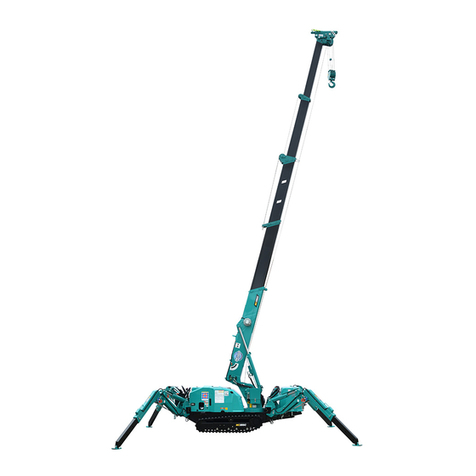
Maeda
Maeda MC285C-3 User manual
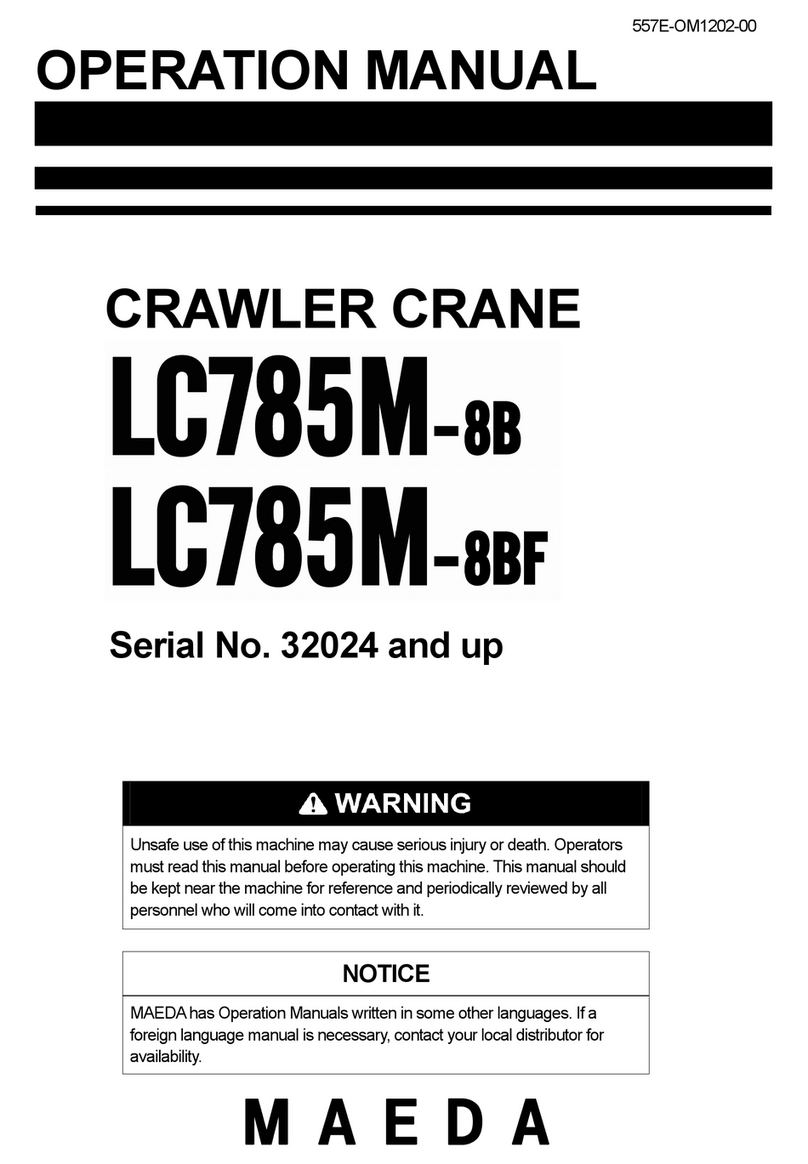
Maeda
Maeda LC785M-8B User manual
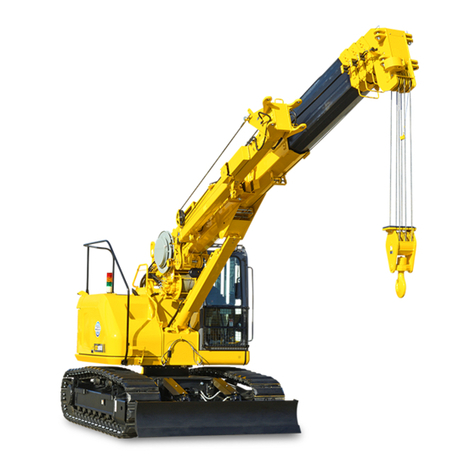
Maeda
Maeda CC1908S-1 User manual
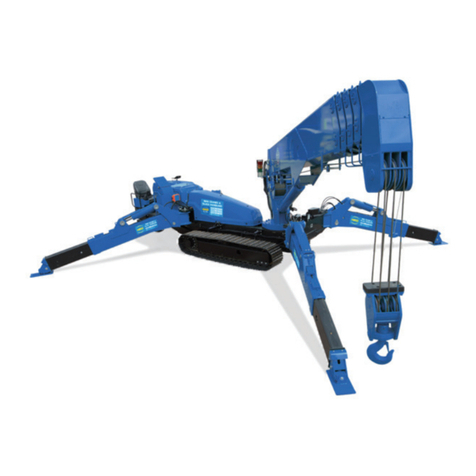
Maeda
Maeda HIRD MC815 User manual
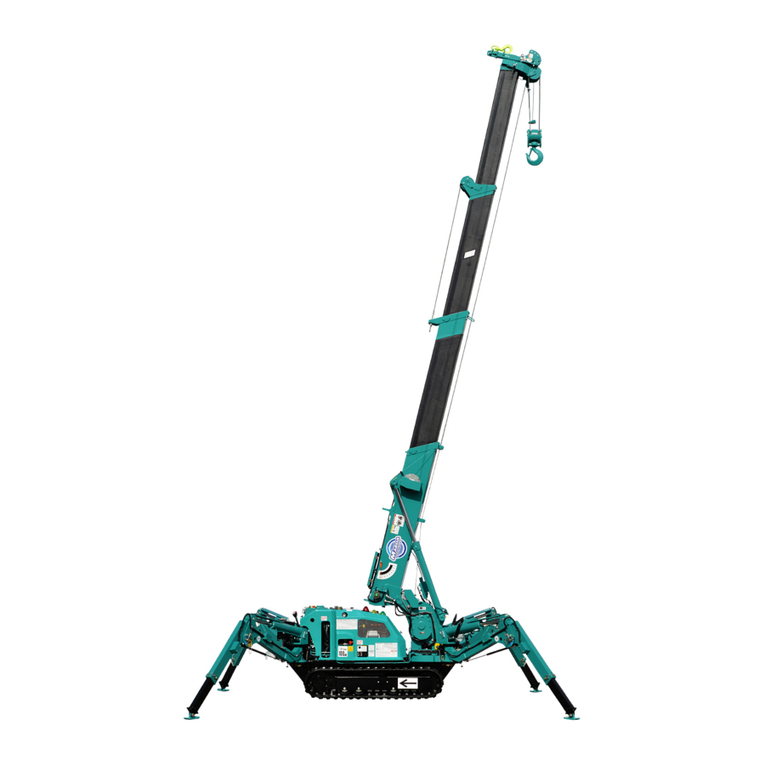
Maeda
Maeda MC-174CRM User guide
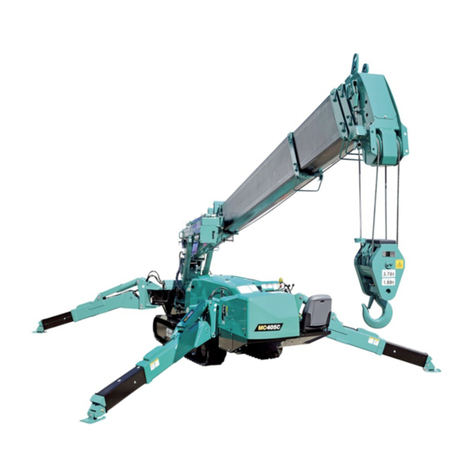
Maeda
Maeda MC-104C-2 User manual
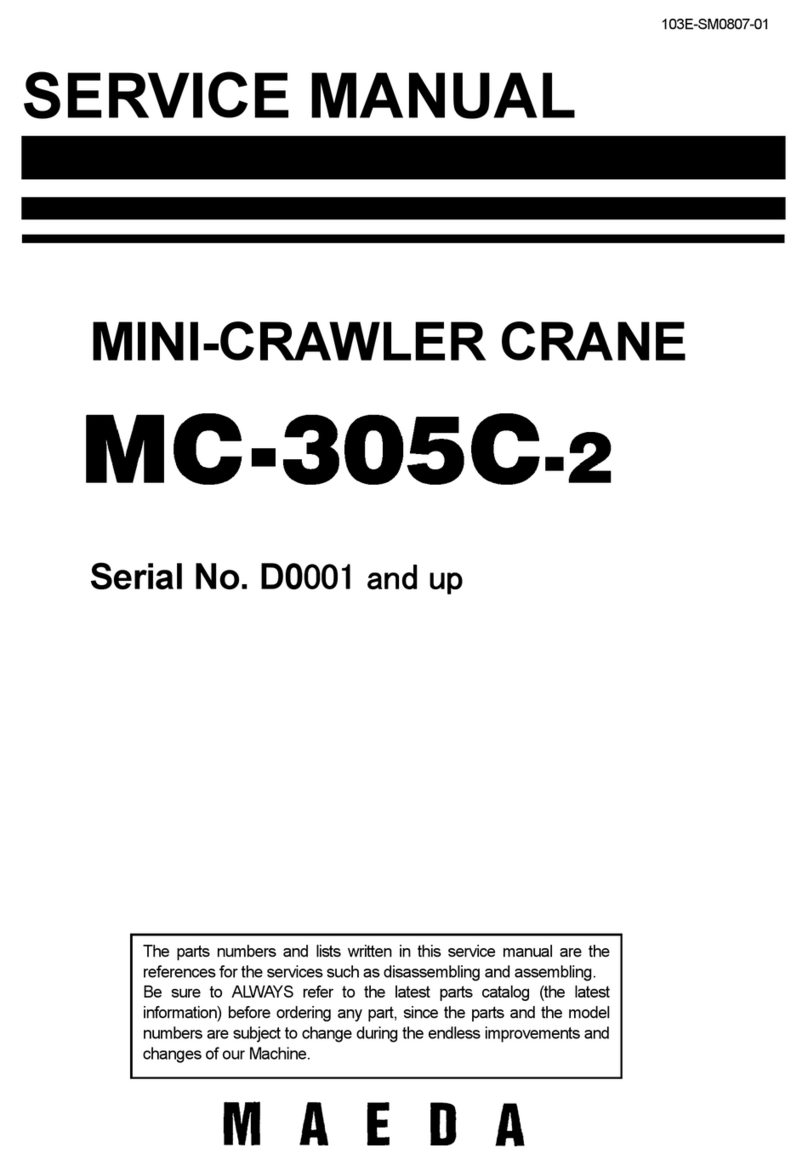
Maeda
Maeda MC-305C-2 User manual
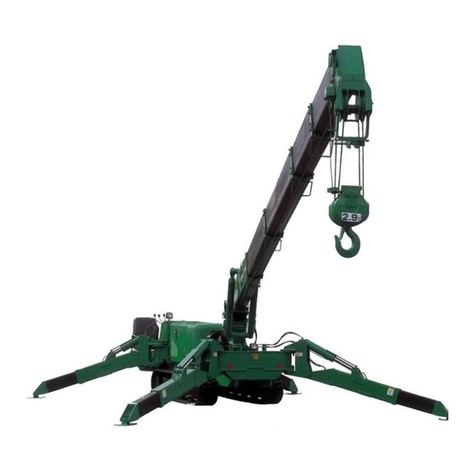
Maeda
Maeda MC-305C-2 User manual

Maeda
Maeda MC-174CRM User manual
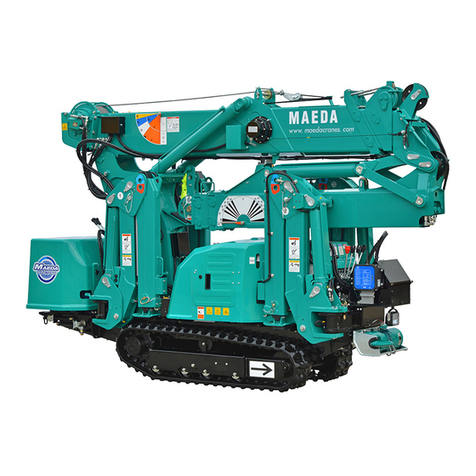
Maeda
Maeda MK1033C-1 User manual
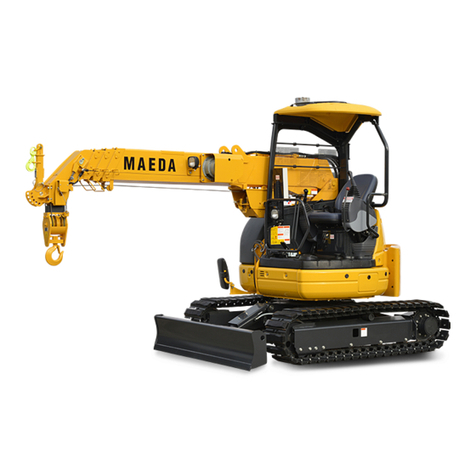
Maeda
Maeda LC383M-5 User manual
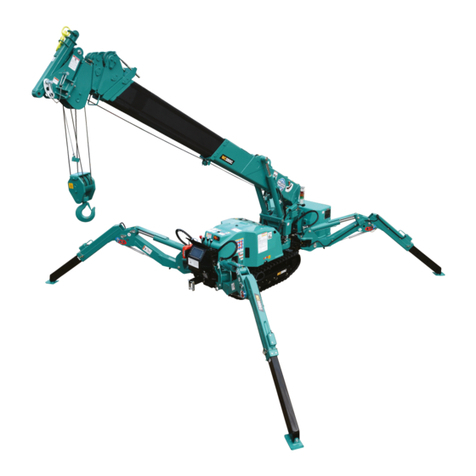
Maeda
Maeda MC-285C User guide
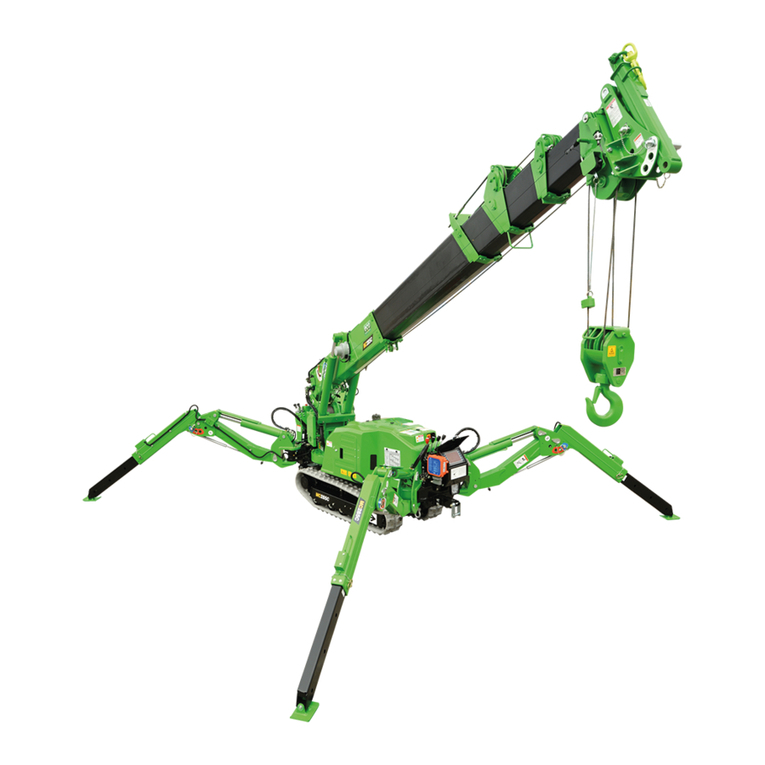
Maeda
Maeda MC285CB-3 User manual

Maeda
Maeda CC1908S-1 User guide

Maeda
Maeda MC-305C-2 User guide
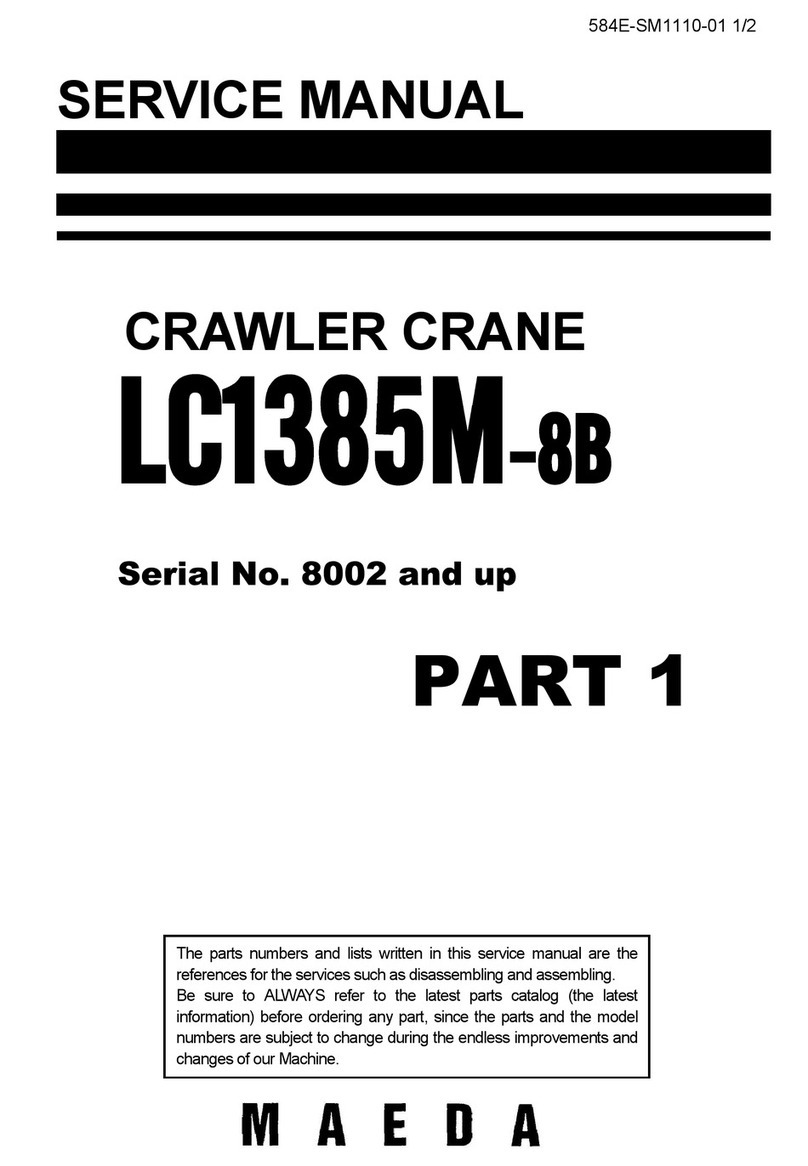
Maeda
Maeda LC1385M-8B User manual
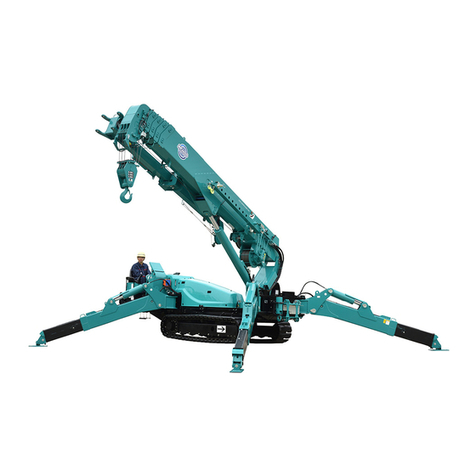
Maeda
Maeda MC815C User manual
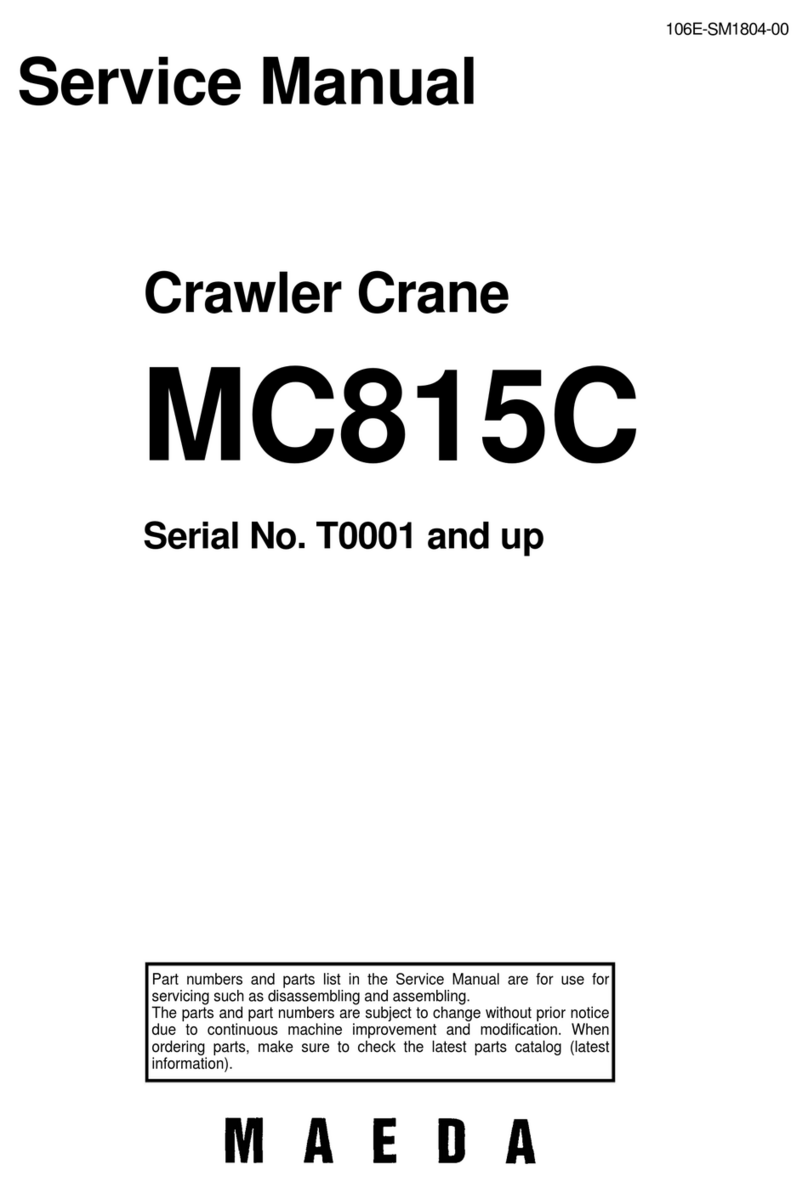
Maeda
Maeda MC815C User manual
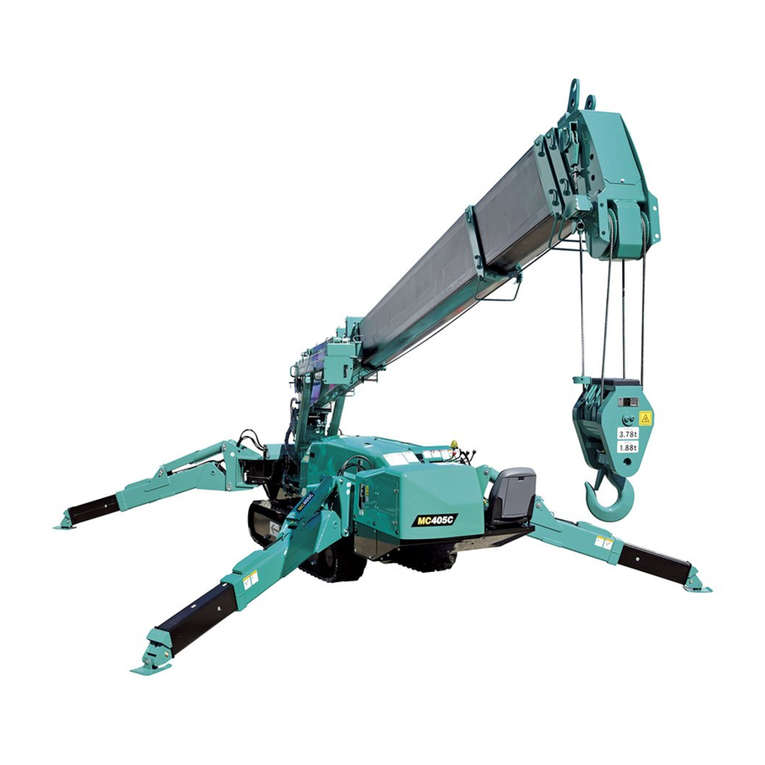
Maeda
Maeda MC405C-3 User manual
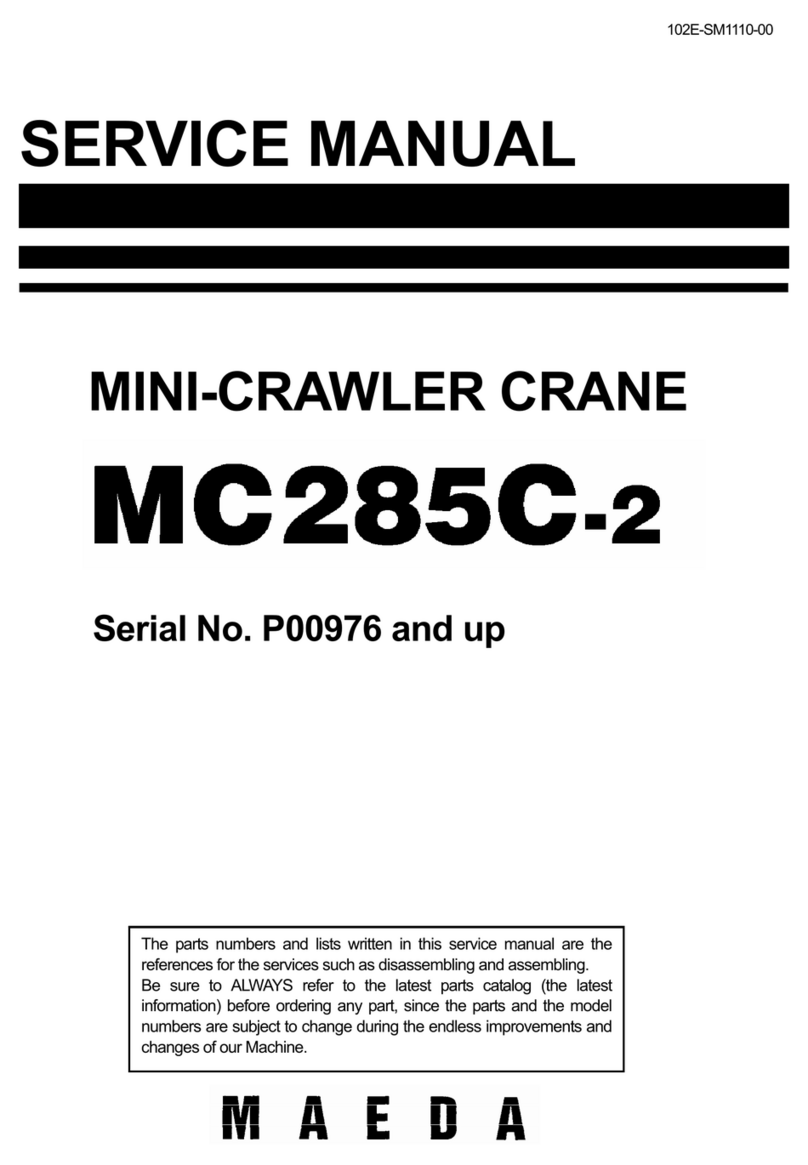
Maeda
Maeda MC285C-2 User manual



